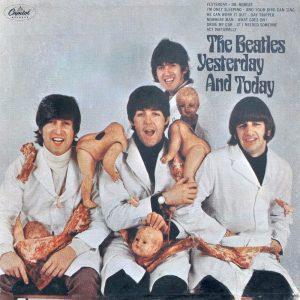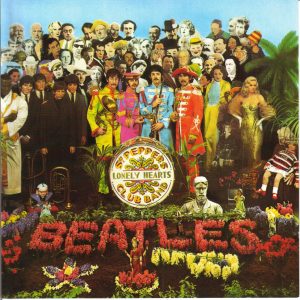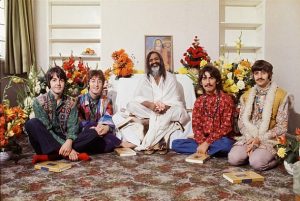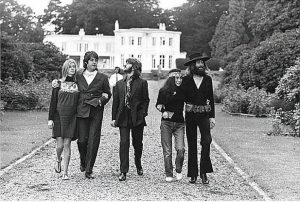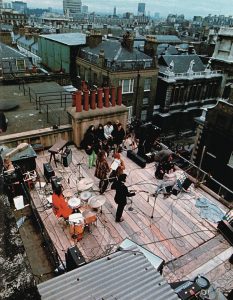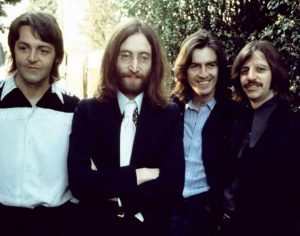Revolution: A Beatles Bio
The Beatles started off as a group called The Quarrymen, founded by John Lennon and his schoolmates in Liverpool, England, 1956. Paul McCartney joined the band shortly afterwards as a rhythm guitarist. George Harrison was a friend of Paul’s and badly wanted to join the band. Though John initially thought the 14 year old Harrison was too young, he eventually agreed to let him join as lead guitar player. In early 1960, John Lennon’s friend and local art student Stu Sutcliffe joined on bass guitar and came up with the band’s name, originally The Silver Beetles before becoming simply The Beatles.
The band got an opportunity to play an extended residency in Hamburg, Germany, but since they didn’t have a full-time drummer, they invited Pete Best to join the group.
After playing for a couple months at various nightclubs in Hamburg, The Beatles had a falling out with their promoter and when the local authorities found out that George Harrison was a minor he was deported. Despite these setbacks, The Beatles would continue to play Hamburg regularly for the next couple of years. In 1961, Stu Sutcliffe decided to leave the group to study art and Paul McCartney took over bass guitar.
When local record store owner Brian Epstein took an interest in the group, and become their manager, it was a major turning point for The Beatles. In February, 1962, they auditioned for Decca Records, who rejected the band. Later, this historic blunder led Decca to sign an up and coming London based rhythm and blues act, The Rolling Stones.
In April of that year, The Beatles returned to Germany only to immediately learn of the death of friend and former band mate Stu Sutcliffe. This tragedy had a major impact on the young men. Their song “In My Life” reflects on Sutcliffe as well as other memories of youth.
Eventually The Beatles signed with Parlophone Records, a division of EMI, managed by George Martin, who would go on to produce almost every one of their records. After their first recording session, The Beatles, George Martin, and Brian Epstein agreed to fire drummer Pete Best. Taking his place would be the drummer from popular Merseyside band Rory Storm and the Hurricanes, Ringo Starr, completing The Beatles historic lineup.
The Beatles recording career began in earnest in 1962, recording “Love Me Do”, and their first number one hit, “Please Please Me.” Please Please Me, also their first album, was released in March of 1963, and shot to number one on the charts. Their fourth single, “She Loves You,” was at the time, the fastest selling record in British history and remained the UK’s highest selling single for 15 years. This success was the start of “Beatlemania” as mobs of press and screaming fans would greet them everywhere they went.
On New Years Eve, 1963, The Beatles were met by throngs of reporters and photographers as they returned home from a tour of Sweden. Present at Heathrow airport that day was none other then Ed Sullivan, who remarked that he hadn’t seen anything like it since Elvis. Brian Epstein negotiated a relatively modest fee of $10,000, a modest sum compared to the $50,000 fetched by Col. Tom Parker for the appearance of Elvis on Ed Sullivan. Epstein and Sullivan agreed that The Beatles would appear on three straight shows, with top billing, opening and closing each program.
The Beatles departed London on February 7th, 1964 and arrived at JFK Airport in New York City, greeted by thousands of reporters and fans. They made their American television debut on “The Ed Sullivan Show” on February 9th, 1964. The results were sensational, with over half of all US television sets tuned to The Beatles on Sullivan that night.
With their stint on “The Ed Sullivan Show” a massive success, United Artist expressed interest in producing a Beatles movie. The resulting effort, A Hard Days Night, was a huge triumph, both financially and critically. Nominated for an Oscar for Best Screenplay, the film by Richard Lester is a considered a major influence on rock films and the mockumentary. United Artist’s main motivation for making the film was to be able to release a soundtrack, as the band’s American label, Capitol Records, was initially slow at releasing The Beatles catalogue in the US.
The success of the film encouraged United Artist to shoot a second Beatles movie, called Help! The film received a higher budget and was more elaborate, and while the film and the album were a huge success, it did not receive the critical acclaim its predecessor did.
In June, 1965, each of The Beatles was made Members of the Order of the British Empire (MBE) by Elizabeth II. This resulted in the first significant public controversy of their careers as many past MBE recipients returned their awards in protest of the pop music act being granted an award typically reserved for military and civic leaders. Ironically enough, a few years later John Lennon would return his own medal as part of his continuing opposition to the war in Vietnam.
That summer The Beatles would go on another tour of the US, starting with their famous Shea Stadium concert in New York City. With an audience of 55,600, including Mick Jagger and Keith Richards, the concert set a world record in attendance for a pop music performance.
In the fall they begin recording what would become the album Rubber Soul. Considered a major leap forward for the band in both songwriting and recording, it contains the first use of the sitar by George Harrison. The Indian instrument can be heard featured on the Lennon sung track “Norwegian Wood (This Bird Has Flown).”
The year 1966 would prove to be full of public relations turmoil for The Fab Four.
The first hint of trouble was the uproar in the United States over the Capitol Records release of the album Yesterday and Today. The album was a mixture of songs from Rubber Soul, the upcoming Revolver, and various single releases. The cover depicted the band dressed in butcher aprons holding chopped-up baby doll limbs. The meaning has been disputed over the years, with some claiming it was a protest against the Vietnam War, while others say it was simply a comment on how The Beatles’ US releases were “butchered” versions of their UK albums. Regardless of the intent, the cover offended many consumers and Capitol was forced to recall the album and paste a new cover on the jacket. Record collectors today consider the original “butcher cover” version a treasure.
The next problem occurred during their tour of Asia. After a successful stop in Tokyo, The Beatles flew to Manila. After a successful pair of concerts, they awoke on the morning of July 5th to a near-riot after a local newspaper ran a front-page story about them snubbing First Lady Imelda Marcos and her children. While Brian Epstein had received an invitation to the Presidential Palace, he had politely declined on The Beatles behalf. This was not the response the First Family had expected. The result was a national outrage that caused The Beatles to fear for their safety. The decision was made to leave the Philippines as quickly as possible. On the way to the airport, the band’s road crew had to shield them from angry mobs. After much effort The Beatles and their crew managed to leave the island and head to their next stop, India.
Shortly after The Beatles arrived back in England, yet another controversy erupted. American teen magazine “Datebook” published an interview on July 29, 1966. Outrage was centered on this quote from John Lennon:
“Christianity will go. It will vanish and shrink. I needn’t argue about that; I’m right and I’ll be proved right. We’re more popular than Jesus now; I don’t know which will go first—rock ‘n’ roll or Christianity. Jesus was all right but his disciples were thick and ordinary. It’s them twisting it that ruins it for me.”
The interview was originally published in the “London Evening Standard” nearly three months earlier with virtually no reaction. However Lennon’s statement infuriated many Americans who interpreted the comment as a claim that The Beatles were bigger than Jesus. The Southern United States was especially indignant, with Beatle bonfires held in Birmingham, Alabama to destroy the band’s albums and merchandise.
1966 was not all bad for The Beatles. They recorded and released their 7th album, Revolver. Widely hailed as a landmark pop music recording, it contained some of their most innovative work yet. “Eleanor Rigby” had no traditional rock instrumentation; Paul McCartney’s lead vocal was backed by strings. “Love You Too” continued George Harrison’s exploration of Indian classical music. The most audacious recording arguably though was John Lennon’s closing track “Tomorrow Never Knows”. Consisting of a hypnotic beat, disorienting tape loops, and effect-laden vocals singing lyrics based on the Tibetan Book of the Dead, The Beatles were approaching new and uncharted territory.
It was around this time that The Beatles gave up touring for good. 1966 would mark the last proper concert performance for the group on August 29th at San Francisco’s Candlestick Park. Indicative of their transition from touring artists to recording artists, they played no songs off of Revolver, believing that they wouldn’t be able to them justice.
1967 would mark a tremendous turning point for the band, creatively and personally. The Beatles, relieved from the pressures of touring and able to record an album without the constraint of having to reproduce it live, indulged themselves in studio experimentation with the help of producer George Martin and engineer Geoff Emerick. After a series of long recording sessions, they would release Sgt. Pepper’s Lonely Heart’s Club Band. From its elaborately designed cover, to its elegantly sequenced songs, to its nail-biting expense to their label, everything about Sgt. Pepper was ground breaking. To this day it is still regarded as a landmark of recorded music, ranking #1 on a list of the top 500 albums of all time by Rolling Stone magazine.
After the massive success of Sgt. Pepper, the band would be struck by another blow to their momentum. Brian Epstein, who nurtured The Beatles from leather-jacket wearing rebels to suit-and-tie media darlings, passed away August 27th, leaving the group in shock.
The Beatles plowed forward with their next project: The Magical Mystery Tour. Having ceased touring, they continued to promote themselves on television by sending film clips set to their singles. The Magical Mystery Tour would be an extension of this; a joint television film and soundtrack release. Largely directed by Paul McCartney, the film was a critical disaster, with the soundtrack fairing much better.
In early 1968, The Beatles traveled to India with their significant others to go to a meditation retreat hosted by the Maharishi Mahesh Yogi in Rishikesh. Ringo and his wife Maureen would leave after ten days. Among other problems, they were unable to tolerate the vegetarian cuisine. Paul and Jane Asher left a couple weeks later due to prior commitments. George was very much interested in the Maharishi and his meditation techniques, however Lennon was very skeptical. He heard rumors that the guru was not celibate, like he claimed, but this has never been substantiated. Regardless, Lennon, Harrison, and their wives would leave the retreat earlier then planned.
Despite their abrupt departure, the trip to India gave them a place free of distraction to compose some of their best songs of the period. Lennon wrote “Sexy Sadie” and “Dear Prudence” as a direct result of his experiences at the meditation retreat. Even Ringo, who had sung on almost every Beatles album but always had his songs written for him, composed his first tune, “Don’t Pass Me By”.
The Beatles would take the songs that they had written in India into the studio and produce their self-titled double album, widely referred to as The White Album. Even by standards set by Sgt. Pepper, The White Album was a radical recording. It featured traditional rock songs (“Back in the USSR”, “While My Guitar Gently Weeps”), ballads (“Blackbird”, “Julia”), as well as more experimental recordings (“Happiness is a Warm Gun”, “Helter Skelter”, and “Revolution 9”). The sessions were anything but pleasant, and most of the songs were more solo efforts then ever before. Also, The Beatles had been struggling in sorting out their finances following the death of Brian Epstein and were distracted by the establishment of their new business venture, Apple Corps. The band was splitting at the seams.
Paul and John were both in new relationships at this time as well. Paul had begun seeing an American woman named Linda Eastman. John was in the process of divorcing his wife Cynthia, and had begun seeing a Japanese avant-guard artist named Yoko Ono. Both couples would wind up married.
After the difficult sessions for The White Album, Paul conceived of a concept he called Get Back. The objective would be a return to form of the good times the band had together. Though details are somewhat muddled, the project was to involve an album, a concert, and a documentary film capturing the process. The Get Back sessions were even more disastrous then those for The White Album. John was never fully on board with the idea and George in particular disliked touring. The film that resulted showed a band struggling to find common ground. A compromise was reached to perform live on the rooftop of Apple Corps. as an ending to the film. The short set with Billy Preston on keyboards would be the last public performance of any kind with all four of The Beatles. The album would not come out until 1970, under the title Let It Be.
Following the calamitous Get Back sessions, most of The Beatles inner-circle assumed it was over for the group. However, Paul McCartney expressed interest in recording another record to George Martin. Martin agreed under the condition that he be given authority over the session. The result was Abbey Road. The album was an especially bright moment for Harrison, whose “Something” and “Here Comes the Sun” were two of the most enduring songs from the album. It is also remembered for its second side, which consisted mostly of shorter, unfinished songs the band fused together for a final medley. Though the album was the last they recorded, it would be released in 1969, before Let It Be.
“And in the end, the love you take is equal to the love you make”
-The End

